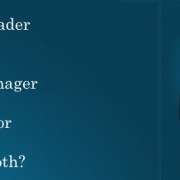Management vs. Leadership
Managers as leaders? Of course they are. But so are many others in an organization. It’s been said that managers look after things, and leaders look after people. Logic might suggest, that if the tasks don’t involve other people, then there is no requirement for leadership.
Now Stephen Covey relates a great story in his book The 7 Habits of Highly Effective People –a group is tasked to clear a path through the jungle. The manager organizes each task such as sharpening machetes, removing brush and making schedules for the workers. The leader climbs a tall ladder and looks over the top of the canopy. After scanning the horizon, he shouts down, ‘Wrong jungle!” To which the manager replies – “Shut up – We’re making progress!”
This story illustrates a somewhat narrow perspective of how a manager may doggedly work to carry out an assignment without questioning the purpose, goal or even its effectiveness. But this is only one example of the difference between the leadership and managers.
The role of manager is an assignment giving one authority over others. The purpose is to organize and direct all resources – including people – to complete tasks efficiently. Management is based upon the assumption that once more than a few people are assigned a task or objective; there is a requirement to have an individual with authority to direct activities. For example in the army you may have a fire team of a few soldiers working independently. Once they require more soldiers, a supervisor – corporal is assigned to lead a squad of say 8-13 soldiers. When several squads combine they require a Sergeant for a platoon and so on. The terms and numbers may well vary among nations.
The second perspective is that all people are at times leaders and they don’t need formal authority to exercise this skill. For example, we all have a way of leading others within our ‘circle of influence’. An example may be when we help a fellow worker, or set an example by taking initiative that gets noticed by others. These can have an impact and may inspire others to take action. This influence of changing other people’s behaviour not often credited to good leadership – and yet it may occur at almost anytime that we are in contact with others.
So, managers are leaders. But as my son once told me when he was only 12….”Dad, just remember you’re ‘special’ and ‘unique’ – ….. just like everybody else”. Next time you have a chance to observe a manager (or anyone with authority), notice how they perform. Do they rely on their authority or their leadership? And how easy is it for others to recognize the difference?
In the next topic we address how we often think of leaders as people in power and control. And yet this may only be a result of their given authority. We will discuss the responsibilities of authority.




